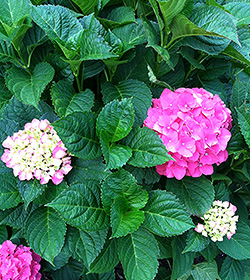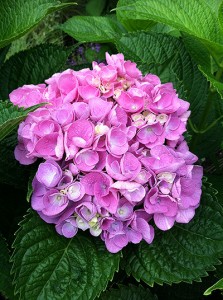Hydrangeas of Every Hue
Posted in Horticulture on August 12 2014, by Sonia Uyterhoeven
Sonia Uyterhoeven is the NYBG’s Gardener for Public Education.

As we read in my post last week, it has been a difficult year for bigleaf hydrangeas (the mophead and lacecap hydrangeas) due to the late frosts in the spring which killed off many of the flowering buds. While weather is often the culprit for the demise of good flowering in hydrangeas, sometimes other factors come into play.
The lessons from this past year are clear: hydrangeas that flower on second-year wood (i.e., where the flower buds form in the previous season) are best sited in protected areas that are not exposed to harsh winter elements, such as strong winds and extreme temperature fluctuations.
Other factors can contribute to a lack of flowers. Too much shade will also hamper flower production, as will fertilizing too often with high nitrogen fertilizers—this will simply produce leafy growth with few flowers. Over- and under-watering your hydrangeas can also weaken the plant and prevent maximum flowering.
Sometimes in the heat of the summer, I see our hydrangeas wilting in the afternoon. Always check your soil; they may not need water, but rather they may be suffering from heat stress. They will perk up as soon as the temperatures start to drop later in the day. If the soil is dry, then the leaves will desiccate and get damaged, so water is required. Hydrangea macrophylla in general does best with morning sun and afternoon shade. Full sun is fine as long as they have ample water and mulch. This is enough to keep the plants happy.
Correct pruning is also important with hydrangeas. Hydrangea macrophylla predominately flowers on old wood, although there are now many good remontant or re-blooming varieties that flower on both old and new wood. Technically, you are supposed to prune hydrangea macrophylla in late summer–removing weak canes and thinning out the plant to a neat framework.
I find it impossible to see what I am doing, so I leave the pruning for the spring–making judicious cuts so that I do not remove too many buds for the upcoming season. I also wait for the spring because (as was the case this year) Mother Nature often comes in and does some pruning herself. Mid-April is generally the time when I can assess winter damage and make my selective cuts.

Last week we took a look at a number of wonderful cultivars —many which were dependent on the soil pH for their color. White hydrangeas generally never change their colors and will remain white regardless. One exception that I mentioned last week was the intriguing ‘Madame Emile Mouillere’ whose petals stay white but the eyes on this mophead can change from pink to blue depending on the soil pH. Like many white blooming hydrangeas, ‘Madame Emile Mouillere’ fades to pink as the season progresses, providing added interest and depth in autumn.
Pink and blue hydrangeas have more plasticity in their color range and you can often play with their colors, to varying degrees. It is not the soil pH, but rather the amount of aluminum available for the plants that dictates the color of the hydrangea. In acidic soil, aluminum is available; in alkaline soil, aluminum is tied up in insoluble forms that cannot be taken up by the roots. Excess phosphorous will also tie up aluminum, even in acidic soils.
To change alkaline soil (which will give you pink hydrangeas) to acidic (which will give you blue), the addition of aluminum sulfate is generally prescribed. If you would like to raise your pH (turning blue hydrangeas pink) then add pelletized lime.
A word of warning – you can only do so much. If you have highly alkaline soil, it may just be best to stay with pink hydrangeas, and the same is true for blue and acidic soils. When changing the pH remember to always get your soil tested first and follow the instructions for the product you are using. Excess aluminum will damage your plant roots and with too much lime, your hydrangea will not be able to enough iron and you will be left with chlorotic leaves.
There are products on the market that try to simplify this process for you such as ‘Color Me Pink’™ (pelletized lime), ‘Color Me Blue’™ (pelletized sulphur) and Espoma® Organic Soil Acidifier (Sulfur and Gypsum).
Colors in hydrangeas can change regardless of soil pH. Some have constantly changing colors; others change with age, some change over time as they settle in and grow. It can take some hydrangeas up to 3 years for the color to settle into something permanent.
For the consumer it is not only important to understand care and limitations, but also to familiarize yourself with the different cultivars. Some varieties are more prone to being changeable and produce flowers that are a delicious blend between blues and pinks. Others tend to swing more in one direction. Some varieties will produce pale hues no matter what you do to the soil, and others are known for their intensity.
Here are some outstanding hydrangeas in our collection—many were donated by Lynden Miller.
- ‘Alpengluhen’ or ‘Glowing Embers’ – nice strong mix of blues and pinks on same plant
- ‘Enziandom’ or ‘Gentian Dome’ – intense blue in acidic soils
- ‘Freudenstein’ – excellent pink in alkaline soils, mauve in acidic soils
- ‘Merritt’s Supreme’ – rosy pink in alkaline and a blend in acidic soils
- ‘Blaumeise’ or ‘Blue Tit’ – cobalt blue flowers in acidic soils
- ‘Brestenberg’ – Deep blue or deep pink depending on soil pH

